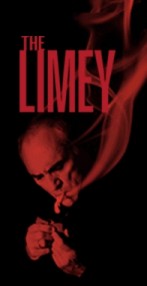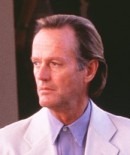 Starring
Terence Stamp, Peter Fonda, Lesley Ann Warren, Luis Guzman, Barry Newman, and
Nicky Katt.
Starring
Terence Stamp, Peter Fonda, Lesley Ann Warren, Luis Guzman, Barry Newman, and
Nicky Katt.Written by Lem Dobbs.
Directed by Steven Soderbergh.
The Limey (1999)
 Starring
Terence Stamp, Peter Fonda, Lesley Ann Warren, Luis Guzman, Barry Newman, and
Nicky Katt.
Starring
Terence Stamp, Peter Fonda, Lesley Ann Warren, Luis Guzman, Barry Newman, and
Nicky Katt.
Written by Lem Dobbs.
Directed by Steven Soderbergh.
Grade: A-
Review by Jeff Vorndam.
Steve Soderbergh and Terence Stamp are the dual stars of The Limey. This is a movie that flies along on a deceptively simple plot with time-manipulative editing and a tour de force central performance. Soderbergh continues to be on a roll: Schizopolis was absurd and hilarious, and Out of Sight seductively entertaining. With The Limey Soderbergh continues to explore themes of familial reclamation and genre satire, while striking new ground conceptually. His range as a director is refreshingly wide. With the recent avalanche of good movies out in theaters (how often can you say this?), The Limey might unfortunately get lost in the shuffle, but it is well-worth seeking and seeing.
The “what” of this film is a trite and true revenge story. We’ve seen the basic
format before in Get Carter and Death Wish. It’s the “how” of
this film that distinguishes it as worthwhile. Terence Stamp plays Wilson, a
newly minted Cockney ex-con who is sort of a walking anachronism. He’s no Austin
Powers though, he’s a tough S.O.B. and when he learns that his daughter was
killed in a suspicious car accident in Southern California, he hops on a jet
to get to the bottom of things. Once in L.A., he hooks up with a couple of his
daughter’s friends, Ed (Luis Guzman) and Elaine (Lesley Ann Warren). After dispatching
some underlings (who are surprised by the spry Cockney), Wilson learns the culprit
is a record producer/drug lord named Terry Valentine (Peter Fonda). Wilson and
Ed proceed to Valentine’s opulent residence up in the hills, and we expect a
bloodbath.
But wait... we’re only halfway through the movie at this point. Wilson can’t smoke Valentine this early in the film can he? Soderbergh reveals added dimensions to Wilson’s character as he bides his time. Rather than shooting Valentine point-blank in a vengeful rage, he touchingly swipes a picture of his daughter that Valentine had hanging on his wall. Wilson isn’t simply an avenging angel, he’s an autumn-yeared father, regretful that he never became close with his daughter because he was in jail.
Terry Valentine is understandably upset that someone is trying to kill him.
He delegates his right hand man Avery (Barry Newman) to rub him out. Avery in
turn subcontracts the job out to Stacy (Nicky Katt), a hitman who’d be at home
in a Quentin Tarantino movie. Stacy, we learn, is being sought by the DEA in
connection with Valentine’s drug money laundering. This circle of thug life
is played effectively for laughs, with Katt getting most of them. The entire
film is filled with dry ironic humor, due in large part to the iconoclastic
casting. When Valentine’s new girlfriend tells him he’s “not specific enough
to be a person,” he’s “more like a vibe,” he grins the grin of one who has feces
feasted since the late 60s. Peter Fonda as Terry Valentine represents the opportunism
of the freewheeling sixties gone to its modern conclusion. Perched high in the
Hollywood Hills, his house would boast a fantastic view if the Los Angelas smog
didn’t obscure it (a point wryly observed to great comic effect by Wilson).
It is noted that his surroundings are built on trust, again an ironic comment
considering the perversion of the ideal of trust a money launderer practices.
The best thing about The Limey is the way the style informs the movie’s
meaning. Most films rely on the story to get their point across, and the style
is simply an extra flourish. In The Limey, Soderbergh employs an arsenal
of creative editing techniques and hand-held camerawork that recalls the exciting
work done in the late 60s by Nicholas Roeg and John Boorman, while simultaneously
reinventing the crime genre for the late 90s. The method is so noticeable, it
becomes part of Soderbergh’s point. Whatever happened to experimenting with
time and adorning the external onscreen environment with the internal world
of the protagonist? If the Nouvelle Vague has gone back out to sea, Soderbergh
seeks to reel in the visual expressiveness that washed ashore and lay like a
stagnant bloated whale in the 1980s. In the movie we see repeated shots of Terence
Stamp on a plane, only we don’t know whether he is on his way to LA or coming
back from it. Consequently, the ensuing action could be an imaginary construct
or a pieced-together memory. Either way, much of what we see has the linked
synthesis of Wilson’s mind. A conversation that starts in one scene spills as
voice-over into the next scene and then back to the first scene with a reaction
shot of the person supposedly doing the talking. This implies the mind is working
in two ways, that Wilson is fixating on the words and a series of images pertaining
to them crop up. 
The repetition of key shots like Wilson striding across the frame in front of blank white wall amplify the contrariness of his character to his surroundings. He’s a refuge from a more pro-active era, a foreigner, a lone wolf, and uncosmetic. One of the running jokes in the movie is the inability of anyone around him to understand his Cockney accent. The amplification of time is achieved through the usual array of jump cuts, but also through clips of a younger strikingly handsome Wilson, that is actually footage from the late 60s Ken Loach film Poor Cow. When the camera focuses in on Wilson’s penetrating eyes, we see a man whose time has passed and whose family has disintegrated. He is angry and regretful, and, unlike Mel Gibson’s character in the recent Payback, we care what happens to him.
The Limey succeeds in creating entertaining and thoughtful cinema from a slim worn starting point. For film fans who admire creative work from one of the best working directors, and for esteemers of strong acting (Stamp is mesmerizing), The Limey is worth seeking and savoring.
| Send us a comment on this review. |  |